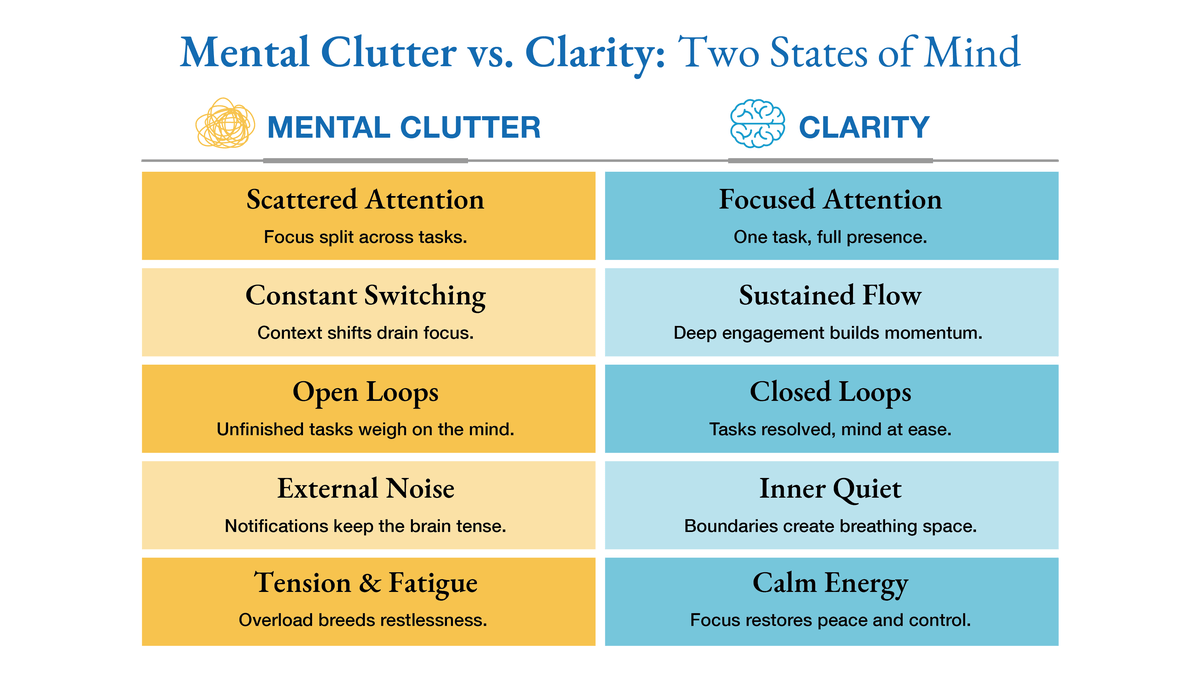Mental Clutter Takes a Very Real Toll
Have you ever ended the day exhausted—not from what you actually did, but from everything circling in your head? That invisible weight is mental clutter, one of the hidden costs of modern life.
Mental clutter is like being in a restaurant kitchen during the dinner rush. Your limited attention is the lone chef, frantically trying to keep up with a flood of orders. Each ticket represents a thought, task, or worry—some quick, others complex. The more tickets pile up, the harder it is to know which to tackle first. That’s mental clutter: the endless stream of demands vying for space in your mind.
Despite countless productivity apps and mindfulness practices, most of us feel more cluttered than ever. The paradox is clear: we’ve never had so many tools to stay on top of life, yet our minds rarely feel clear.
From Physical to Mental Clutter
Not long ago, clutter meant something you could see and touch—the stacks of magazines in the den, the boxes in the garage, the kitchen drawer that refused to close. Annoying, but concrete. You could roll up your sleeves, sort through the mess, and haul bags to the curb.
Today’s clutter is different. It’s not in our closets but in our heads. Mental clutter shows up as the tabs you can’t close, the tasks that nag at you, the flood of communications that crowd your thoughts. Unlike physical clutter, it’s invisible, insidious, and harder to manage. It requires a different kind of cleanup—one that starts with understanding what’s happening inside the mind.
It’s also no surprise the phrase mental clutter has become popular; it names a problem that has grown all too common in our digital age—the opposite of clarity.

Why Are Our Minds So Cluttered?
External Forces
Several outside forces drive mental clutter. Much of today’s technology is engineered to capture—and monetize—our attention. These systems operate using principles of variable reward scheduling—the same mechanism found in slot machines—where notifications, ads, and endless feeds keep us perpetually scrolling (1).
This attention economy profits from keeping our minds in a state of low-level anticipation.
Our hyper-connectedness adds to the noise—texts, emails, and pings create an always-on expectation that makes stillness rare. Modern life also bombards us with more commitments than the mind can hold, while bite-sized media trains us to consume in fragments instead of sustaining deep thought.
Internal Tendencies
But clutter doesn’t come only from the outside. Our brains are wired to chase novelty, and today’s updates exploit that instinct, leaving us restless and reactive.
Unfinished tasks or unresolved worries—what psychologists call open loops—linger in the background, quietly draining energy until they’re closed. These tendencies magnify the clutter our environment feeds us.
With both external pressures and internal wiring pushing against us, it’s no wonder mental clutter has become the norm in the age of distraction.
How Mental Clutter Affects Us
Cognitive Costs
Mental clutter scatters attention. With too many inputs competing at once, it becomes harder to prioritize, harder to think deeply, and harder to finish what we start. Focus gets replaced by constant switching, which drains energy and reduces productivity.
Emotional Toll
Clutter also weighs on mood. An overloaded mind often feels anxious, restless, or guilty—guilty for what hasn’t been done, restless from unfinished tasks, or anxious from the constant sense of being behind. Over time, this creates a baseline hum of stress that undermines peace of mind.
The Bigger Picture
These costs don’t just make us less effective in the moment. Left unchecked, mental clutter erodes clarity, decision-making, and overall well-being.
The Hidden Mental Health Issue
Mental clutter has become one of the signature challenges of modern life. Unlike physical mess, it isn’t visible, yet its effects are real—scattered attention, restless energy, and a constant sense of overload.
Beyond productivity, cognitive science shows that ongoing distraction can heighten tension, disrupt sleep, and erode mental resilience. Research on “attentional residue” shows that even brief interruptions leave a lingering focus cost, making it harder for the mind to fully recover between tasks (2).
Over time, this constant state of mental fragmentation can mimic a low-grade stress response—keeping the nervous system on alert and draining the capacity for calm focus and reflection. The result isn’t only cognitive fatigue but emotional strain: irritability, anxiety, and diminished sense of control.
In this way, mental clutter isn’t just an inconvenience; it’s an underrecognized mental health issue—one that shapes how we think, feel, and function in daily life.
The Path to Clarity
Where clutter brings scattered attention, restless energy, and the nagging sense of being behind, clarity brings intentionality—steady focus, calm momentum, and the freedom to move through the day with purpose.
The result isn’t just greater productivity—it’s peace of mind, renewed energy, and a deeper sense of control over your life. When mental clutter dominates, even meaningful activities lose their spark. Clarity restores not only focus, but also connection—to our goals, relationships, and sense of purpose.
In the next piece, we’ll explore what may be the single most powerful tool for cutting through mental clutter—a true antidote if you commit to using it. Practiced deliberately, it can offer one of the most precious of assets: the power to serve only the “orders” that truly matter.
REFERENCES
- Eyal, N. (2014). Hooked: How to Build Habit-Forming Products. Portfolio/Penguin.
- Leroy, S. Why is it so hard to do my work? Organizational Behavior and Human Decision Processes, 2009; 109: 168–181.



